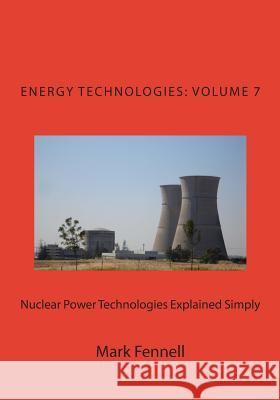Nuclear Power Technologies Explained Simply: Energy Technologies Explained Simply, Volume 7 » książka
Nuclear Power Technologies Explained Simply: Energy Technologies Explained Simply, Volume 7
ISBN-13: 9781484166390 / Angielski / Miękka / 2012 / 154 str.
Nuclear Power Technologies Explained Simply: Energy Technologies Explained Simply, Volume 7
ISBN-13: 9781484166390 / Angielski / Miękka / 2012 / 154 str.
(netto: 100,65 VAT: 5%)
Najniższa cena z 30 dni: 105,39
ok. 16-18 dni roboczych
Dostawa w 2026 r.
Darmowa dostawa!
Nuclear Power Technologies Explained Simply is your one-stop resource for understanding everything related to Nuclear Power. This book is designed for citizens and policy-makers who want to become more fully informed regarding the science and technology of nuclear power. All aspects of nuclear technology are explained simply enough for any reader to understand. At the same time, enough detail and data is provided for the reader to make intelligent decisions. Within this book you will find answers to all of your questions related to nuclear power, including: How do nuclear power plants work? What are the main components and design options of nuclear power plants? What exactly happened at Three Mile Island, Chernobyl, and Japan? How do we make nuclear power plants safer? How dangerous is each type of radioactivity? What do the units of radioactive decay mean? How do we store nuclear waste safely for thousands of years? and many other questions related to nuclear power. In addition, this book provides extensive data tables related to nuclear power. This is the most comprehensive and complete collection of data related to nuclear power currently available. Types of data include: Complete list of radioactive isotopes, including decay type, new atom created, and half-life. Complete list of half-lives for all radioactive isotopes, listed in order of decay time. Decay sequences for multiple decay isotopes. Melting points of nuclear fuel and fuel rods. Dosage of absorbed radioactive decay and the resulting effect on human health. Suggested Nuclear Standards from ANS and NRC Nuclear Power Technologies Explained Simply consists of the following chapters: 7.1 Overview of Nuclear Power Explains the basic types of nuclear reactors and how they work. 7.2 Creation of Energy Explains how nuclear fuel is converted into energy. 7.3 Operation of Nuclear Power Plants Discusses the operation of nuclear power plants, types of nuclear reactors, main components and design options. 7.4 Science of Meltdowns and Explosions Explains the science of meltdowns and explosions in great detail. 7.5 Three Mile Island Explains the event in a series of steps which are easy to follow, supplemented by analysis of the incident. 7.6 Chernobyl Explains the event in a series of steps, supplemented by analysis of the incident. 7.7 Fukushima Japan Explains the event in a series of steps, supplemented by analysis of the incident. 7.8 Making Nuclear Power Plants Safer Learn all of the most important techniques for making nuclear power plants safer. 7.9 By-Products and Radioactivity Explains the science of radioactivity, including characteristics and process of each type of decay. Discusses the practical implications of different half-life values. 7.10 Health Issues of Radioactive Decay Examines every aspect of radioactive decay on human health, including routes of entry, penetration, mechanisms of each type of decay on the cells, and overall health dangers. 7.11 Measuring Radiation All units of radiation measurements are defined and explained, with additional notes that may help the reader. Units of measurement in context. Quick guide to the dosage of radioactivity and the resulting biological effects. Discusses devices such as Geiger Counter and Film Badge. 7.12 Storing Nuclear Waste Steps required to store nuclear waste for long periods of time Possible dangers to the stored nuclear waste followed by methods to minimize those dangers. Examines in the Yucca Mountain site in great detail, focusing on the geology and the design of the facility. Comprehensive Data in the Appendix: Data was compiled from multiple sources. Therefore in this resource you have a very comprehensive set of data on radioactive decay. In total, this book is the ultimate resource for citizens and decision makers on nuclear power technology. This book will guide you through all the science and answer all of your questions."
Zawartość książki może nie spełniać oczekiwań – reklamacje nie obejmują treści, która mogła nie być redakcyjnie ani merytorycznie opracowana.











